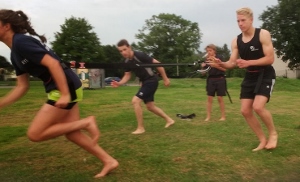Speed Training Exercises
“Build the quality, then learn to endure it”
 This month of our internship we have been learning about speed and the most effective ways to train for it writes Matt Durber.
This month of our internship we have been learning about speed and the most effective ways to train for it writes Matt Durber.
The speed training I have experienced up until now has typically consisted of a few drills through ladders and over hurdles to warm up followed by 50-100m sprints with walk back recovery.
(Pictured are some speed resistance drills being done in Willand, Devon by our ADC athletes).
Although these exercises are performed at maximum intensity, it is more speed endurance as there is little recovery time in between efforts. Training this way is also very limited, as at no point are you training to make the 50m run faster. As James said “build the quality, then learn to endure it”
When observing James coaching the speed drills to athletes, it immediately became clear that there is a lot more to running fast than just maximal effort. This week the focus was on reducing ground contact time when running.
James introduced a number of drills and the complexity of them soon became clear with athletes interpreting instructions in their own way and performing completely different techniques (some not too dissimilar to the moon walk).
The take home message for me is to go away and practice the drills until I have learned them well enough to think about, demonstrate and explain all at the same time…easier said than done!
How to plan your speed training
As well as knowing the training tools to increase speed, it is important to deliver the coaching in a way that will benefit the athlete the most. James’ recommendation was to include a small amount of speed training regularly within a training plan.
Fatigue will hinder the ability to run at full speed so it is better to perform a small amount at the start of a fitness or team training session when fresh. This should be done regularly throughout the week to reinforce the mechanics.
I have also learned that in addition to planning the drills to use each session, it is important to allow time for the athletes to practice the skills when running. This can be done by interspersing drills with 2 or 3 sprints focussing on the technique.
These running techniques and coaching tools are new to me so I look forward to learning more and watching the athletes develop over the next few weeks.
Matt Durber

Thanks Matt.
Running is a complicated activity, by taking one part out, drilling it, then repeating as part of a whole, it is easier for the athletes to improve.
Rather than just “run faster”